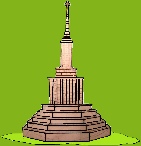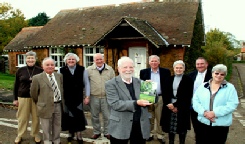
 Local Business, Food, Accommodation
History Group
Local Events
Local Business, Food, Accommodation
History Group
Local Events




 Summary of Castle Rising
Summary of Castle Rising
















Ann Whiting
Castle Rising – 13th -
The building of the Castle at Rising and its elevated status as a Borough was probably due to it being a port in Saxon times. The D’Albini family were to remain Lords of the Manor for about 100 years. When Hugh d’Albini died on 7th May, 1243 with no direct heir, his vast inheritance was divided between his four sisters. One of them, Cecily, took Castle Rising as her share and the Lordship passed to her husband, Roger de Monte Alto, also referred to as de Montalt, de Mohaut, de Montealt or de Mold. This second dynasticfamily who had other Estates, were to remain Lords of the Manor for nearly 100 years from 1243 -
Lion Rampant (silver) – the de Montalt Shield
Many changes were happening in England between the years 1243 -
As well as internal civil fighting, the Crusades lingered on until the last Christian city Acre fell in 1291. The English were now asserting their identity as a people who provoked many problems with the French. There were many altercations with them and also with the Scots. The Battle of Bannockburn in 1314 resulted in a Scottish victory. The barons were required to provide knights to fight and archers to fight for the king so they needed to be strong and able leaders.
This period can be viewed as a time of great brutality and cruelty with its fighting and punishment by torture but the people survived, even through times like the famine of 1315-
Medieval society was dominated by men and the women were seldom involved in warfare, land management or government. The lives of ordinary women mainly revolved around their families with the running of household affairs each day and the bearing and rearing of children. Their role was vital though as part of the domestic economy, beginning with any dowry brought to the marriage. Sometimes they extended their labour in the running of the household into small-
Women of noble birth had other challenges. They were responsible for the management of large households of servants and retainers as well as families of their own. Their presence graced banquets, and other social events held at the court or in the castles of the nobility. The ability to do so was important as often their husbands were away fighting, attending Parliament, visiting other Manors or about the King’s business. Even when widowed they sometimes took over the management of their late husband’s estates. It was important to keep estates together and legally the oldest surviving son inherited any title held and lands from his father. Widows generally received about a third of the estate during their lifetime or until they remarried with permission from the King. An example of this can be seen from some Court business of Edward III at Castle Rising and concerns an order to Hugh de Moriceby, escheator in County Cumberland regarding Christiana, widow of William de Loghmaben to cause dower to be assigned………….tenant in chief of all the lands which belong to her husband in that baliwick, taking her oath that she will not marry without the King’s licence. 1
When there was no male heir, women could inherit as did Cecily d’Albini and her sisters.
Daughters were usually given a substantial dowry at the time of their marriage. This was controlled by their husbands for the duration of the marriage but could be reclaimed by the woman if her husband died. If she chose a religious life instead or entered a nunnery because no suitable husband could be found, a portion might be given to the religious house.
So when Cecily d’Albini took Rising Castle as her share of inheritance, the control passed to her husband Roger, the first Castle Rising de Montalt lord of the manor, who himself came from a lineage of extremely important Norman barons.
Roger de Montalt descended from the family of Maude, originally Lords of de Monte Alto in Italy and established in England by Eustace de Monte Alto, surnamed the Norman Hunter. He was a soldier of the Conquest and very little is known about him other than he was possibly the first Baron de Montalt. William Taylor, who was a Fellow of the Lynn Society of Antiquaries and great friend of Daniel Gurney, brother to reformer Elizabeth Fry, worked out an early genealogy chart in 1850 and refers to him as Norman. It is difficult sifting through the various interpretations of the records to identify the correct person, especially as so many of the de Montalt heirs held the name Roger or Robert. Reference has been made to other research and documentary evidence to make this article as accurate as possible. Taylor’s chart was a reasonable attempt to list the de Montalt family but now shows some inaccuracies. This is mainly due to modern resources and popular interest in genealogy2. Any usage from this is made as and when necessary, especially if it is relevant and supports previous personal research in this area and disagrees with Taylor.
It was also the custom to have an Inquisition Post Mortem on those of noble birth and useful when researching medieval lineages as well as the other primary sources that have now been translated as well as secondary sources like books.
Huge tracts of lands were given to Hugh (Lupus) de Montalt, (2nd generation) by William the Conqueror in gratitude. This included the manors of Montalt and Hawarden (Flint) which formed part of the county Palatine of Chester and its stewardship. Hawarden became an important residence by the de Montalts as it held a peculiar geographical location. It was situated in the only part of the Marches through which access could be obtained by the English to the heart of North Wales and subsequently rendered it the scene of many of the most important events connected with the subjugation of Wales and its people and the scene of much fighting.
For more information click on button
 complete essay on the de Montalts
complete essay on the de Montalts